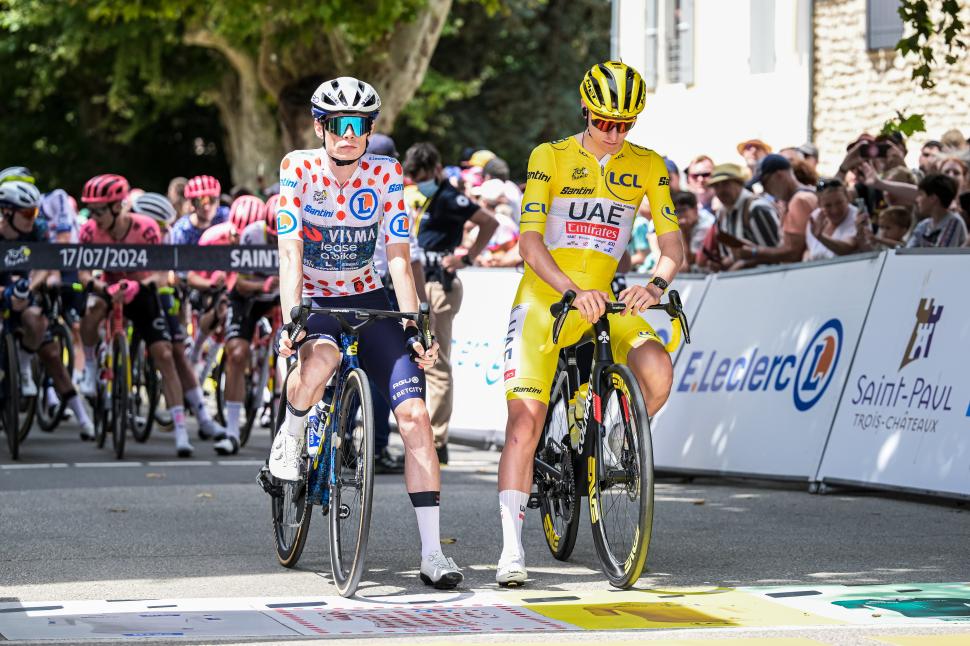- News
- Reviews
- Bikes
- Components
- Bar tape & grips
- Bottom brackets
- Brake & gear cables
- Brake & STI levers
- Brake pads & spares
- Brakes
- Cassettes & freewheels
- Chains
- Chainsets & chainrings
- Derailleurs - front
- Derailleurs - rear
- Forks
- Gear levers & shifters
- Groupsets
- Handlebars & extensions
- Headsets
- Hubs
- Inner tubes
- Pedals
- Quick releases & skewers
- Saddles
- Seatposts
- Stems
- Wheels
- Tyres
- Tubeless valves
- Accessories
- Accessories - misc
- Computer mounts
- Bags
- Bar ends
- Bike bags & cases
- Bottle cages
- Bottles
- Cameras
- Car racks
- Child seats
- Computers
- Glasses
- GPS units
- Helmets
- Lights - front
- Lights - rear
- Lights - sets
- Locks
- Mirrors
- Mudguards
- Racks
- Pumps & CO2 inflators
- Puncture kits
- Reflectives
- Smart watches
- Stands and racks
- Trailers
- Clothing
- Health, fitness and nutrition
- Tools and workshop
- Miscellaneous
- Buyers Guides
- Features
- Forum
- Recommends
- Podcast
news
What is carbon monoxide rebreathing and why is the entire Tour de France talking about it? Tadej Pogačar and Jonas Vingegaard insist it's "nothing suspicious" and "just a simple test", but others are less convinced
Carbon monoxide has been the talk of the Tour de France this week, the race's biggest stars and teams fielding questions on a controversial 'rebreathing' technique used to test and optimise riders' altitude training. However, given the health questions that inevitably follow an admission about inhaling a deadly gas such as carbon monoxide, plus the potential for the practice to be abused for performance gain, it's not hard to see why so many have raised safety and ethical concerns.
The discussion was sparked by an at-length piece by Escape Collective who broke the news that top-level Tour de France pros, namely riders on UAE Team Emirates, Visma-Lease a Bike and Israel-Premier Tech, have access to a carbon monoxide rebreather — an expensive piece of kit that allows for precise dosing of the gas into the lungs.
Now, at this point the natural reaction is almost certainly to respond: why? For what possible reason would you wish to inhale a poisonous gas that can make you seriously ill if you breathe it in?
Well, carbon monoxide testing provides an accurate means of measuring haemoglobin (a protein that facilities the movement of oxygen in red blood cells), so for example during an altitude camp it can be used to track a rider's progress over a block of training.
The practice does not break anti-doping rules and is a technique that has been around for decades in the worlds of science and medicine. Where things get more murky, however, is with the potential for misuse.
Inhaling carbon monoxide — using the same device as is used for the tests carried out at UAE Team Emirates and Visma-Lease a Bike altitude camps — could assist riders' bodies to produce more red blood cells, an act that, while not banned by WADA, one would assume is in conflict with the anti-doping authority's stance against artificial manipulation of blood.
At this point it's worth pointing out that there is no suggestion cycling teams are using the carbon monoxide rebreathing device for any purpose other than haemoglobin testing. However, equally, it's not difficult to see how the situation has raised concerns about the potential for athletes to abuse such equipment in search of performance gain, potentially risking their own health in the process.
This is an ethically questionable practice that has likely already arrived in sport, the US-based cycling website reporting that: "Several other sources claimed the technique was already in use in various sports. One sports scientist confirmed he had seen an athlete — in a sport he would not name — inhaling carbon monoxide for performance gains and conveyed his concern the practice could prove a blight on the Paris Olympics."
"There is nothing suspicious about it" and "just a simple test" — what have those riders and teams using carbon monoxide rebreathing had to say about it?
The communication from UAE Team Emirates, Visma-Lease a Bike and Israel-Premier Tech has been clear — it is only used for testing and monitoring altitude training. Never for direct performance gain.
There was some confusion this week when Tadej Pogačar initially said: "I don't know what it is", when responding to a question about the practice. UAE Team Emirates then promptly offered a clarifying statement to The Times' David Walsh admitting they do use the carbon monoxide device. The current race leader then told reporters 24 hours later that he "didn't quite understand the [previous day's] question".
"It's a test in altitude camp to see how you respond to altitude," he elaborated. "You need to do this test, it's like a two or three-minute-long test. You breathe into a balloon for one minute and then you see the haemoglobin mass, and then you need to repeat it two weeks after.
"But I did just the first part of the test. I never did the second part because the girl who was supposed to come after two weeks didn't come. It's not like we're breathing exhaust pipes every day in the cars. It's just a pretty simple test to see how you respond to altitude training."
The Slovenian's great rival Jonas Vingegaard too has been quizzed on his use, explaining: "It's to measure how much haemoglobin you have in your blood. There is nothing suspicious about it.
"We measure how many red blood cells you have in your blood and the effect of altitude training camp. One thing is what you have thought training at altitude did for you. Now we actually have something that can measure it. They [the doctors] say that they send something into the lungs that is similar to smoking a cigarette. We measure the day we get to our high altitude camp and then [on] the day we go back down. Then we see the difference in how much haemoglobin is built up. There is nothing more to it."
Israel-Premier Tech also said their "sole use of the Detalo Blood Volume Analyzer is for testing purposes to measure the impact of altitude training".
A UAE Team Emirates spokesperson added: "It is a well established, safe, professional method that is backed by a very large amount of research. It is used widely by athletes, climbers and other persons who are exposed to altitude for professional sports or other physical activities."
"It's not a therapy; it's a diagnostic tool that we use to essentially work out what our athletes' physiology is," the team's medical director Adriano Rotunno told Escape Collective, emphasising that there is no performance enhancement to the measurement method.
Others have been less relaxed about the use of carbon monoxide rebreathers, Uno-X Mobility telling Escape Collective it "is not something we are even considering", while EF Education-EasyPost boss Jonathan Vaughters also nailed his team's colours to the mast: "It's not something we have ever done or would do."
Both teams also didn't see the benefit in measuring haemoglobin mass, with another source unequivocal in their condemnation of the potential further use of a rebreather to inhale carbon monoxide for performance gain, telling Escape Collective: "That would be blood doping, make no mistake."
All credit to Escape Collective for breaking this story.
Dan is the road.cc news editor and joined in 2020 having previously written about nearly every other sport under the sun for the Express, and the weird and wonderful world of non-league football for The Non-League Paper. Dan has been at road.cc for four years and mainly writes news and tech articles as well as the occasional feature. He has hopefully kept you entertained on the live blog too.
Never fast enough to take things on the bike too seriously, when he's not working you'll find him exploring the south of England by two wheels at a leisurely weekend pace, or enjoying his favourite Scottish roads when visiting family. Sometimes he'll even load up the bags and ride up the whole way, he's a bit strange like that.
Latest Comments
- Paul J 22 min 32 sec ago
Poor 6 year old was killed by while cycling by a lorry driver in Galway over the weekend. ...
- mdavidford 22 min 42 sec ago
'Sold Secure rated' isn't particularly informative without mentioning the actual rating (in this case the lock is Bronze rated).
- Velophaart_95 22 min 45 sec ago
It might not be popular, but in some respects he's right; how can you have a sporting event, with no winners for 7 consecutive years? In virtually...
- cyclisto 27 min 43 sec ago
This is true too! Maybe I had got used to Carrera brand name as a bicycle brand, forgetting the fancy 4 wheeler with the same name.
- Secret_squirrel 47 min 34 sec ago
Yet you clearly do need perspective - its all over your response. It tells you that 40 cars passed you safely but yet you've been triggered by...
- Hirsute 1 hour 7 min ago
I'd find a physio who would have a look. They will do tests to determine where the issue lies, the extent of mobility and maybe some exercises....
- Miller 1 hour 13 min ago
An uh-oh email signifying that it took Tadej Pogacar to dethrone you, that's pretty impressive. You'd want to keep that email.
- Rendel Harris 1 hour 29 min ago
I wouldn't mind, but I would like the caveat that it should come after I've enjoyed at least one post-ride pint of beer. Sure many others have...
- Backladder 1 hour 34 min ago
It was a bit of a tongue in cheek suggestion
- chrisonabike 2 hours 33 min ago
The thing we're envious of over here in the UK is ... any largely motor vehicle-free area (still not normal for UK). Never mind one with formal...




Add new comment
12 comments
One essential point seems to be ignored by nearly anyone who is bringing this up:
It's not on the doping list. And as it is not on the list, it is not illegal.
What is fine is that, if that method is used (which is not even proved), that it gets on the anti-doping-list … but until then, it's not illegal.
In the latest episode of the Radio RTW - Podcast (sorry, german only) Max Walscheid, who studied in medical science, rants a lot about this. But he also claims, that he would perfectly fine if that method would be put on the list as it's really dangerous (more to amateurs than pros, as pros will get supervision while amateurs not, but anyhow, it;s to dangerous).
But again, that carbonmonoxid discussion is ridicolus as just someone brought it up as an theory. The Keto discussion last year was more real … but it was done in the same schema.
I don't buy it.
Pretty sure you could take a pinprick of blood when required, to test haemocrit level, which is effectively what the CO test does?
In actual fact, is the old 50% "health check" rule still in place from when there was no test for EPO? I'd be interested to know what Pogačar's haemocrit is.
I suspect the CO "test" is simply a smokescreen to allow for additional stimulation of haemoglobin production.
If it has the potential to be abused then it will be, sooner or later, by one team or another.
If it can raise their hematocrit to just under the legal limit then someone will take advantage of that.
"poisonous gas that can make you seriously ill"
and dead
Pasting my comment from the daily blog:
The CO breathing described is NOT doping. It's a standard method in (sports) physiology to determine the total haemoglobin mass in a human. You take a sample of someone's blood and you measure the percent of carboxyhaemoglobin. You then take a volume of oxygen and add a fixed, known amount of CO to it. You then get the subject to rebreathe this volume. It has been established that with X (I forgot how much) rebreathing, effectively all the CO will have been absorbed by the subject and be bound to their blood. (CO binds to haemoglobin preferentially above O2 and CO2). You take another sample of blood and determine the fraction of carboxyhaemoglobin.
You know now:
1. The fraction of carboxyhaemoglobin before CO rebreathing
2. The fraction of carboxyhaemoglobin after CO rebreathing
3. Exactly how much CO went into the subject
Knowing the increase in the fraction in a known quantity of sampled blood from a known total amount of CO, you can work out the total amount of haemoglobin in the blood.
This is - in the immediate term - actually performance _decreasing_. Because the CO binds strongly to that haemoglobin, and you've basically lost that haemoglobin for oxygen transport for X days (2 to 5 days? I forget). I wasn't blinded, but it seemed to me I could notice the negative effect the next few days.
However, if done repeatedly for a period of time [not sure how long - probably has to be at least weeks] and then stopped, it may be performance enhancing. Because your body perceives it has /less/ haemoglobin, and so it makes more. Your body is trying to bring the fraction of /available/ haemoglobin to a normal level (kind of compensating, similar to altitude training). Then, when you stop the CO rebreathing, after X days, the previously CO-bound haemoglobin manages to unbind and also becomes available, and you have an increase in available haemoglobin - for a while.
I'm not a sports physio Ph.D. myself, but I've been put through the CO/haemoglobin mass method as part of a sports science study (years and years ago), and the post-docs were explaining it to me.
Carbon monoxide "binds" to haemoglobin with an affinity 200x to 240x that of oxygen - and the half-life of the unfortunately quite stable complex it forms (carboxyhaemoglobin) is of the order of 5 to 6 hours (without treatment). These factors contribute to its lethality at even small ambient concentrations. As an aside, get your boiler serviced regularly (a friend and his young family nearly died this way).
I appreciate that it can be used to measure Hb levels and that there are going to be ways of carefully calculating a safe dose (as much as you would get from eg a cigarette) - but I do not understand. Surely there are easier ways to measure Hb?
I assume they use only a tiny amount of CO. It doesn't need to be much, they just need to be able to measure the difference in the blood sample (the initial sample should be 0 really I think?). I did seem to notice having a very faint headache / head dullness immediately after though.
As for other ways, no idea. Is there anything else that binds to haemoglobin above O2 and CO2 and is known safe? Just the preferential factor is surely going to mean it has same problem as CO?
How else could you determine the total amount of Hb? You can't simply take all the blood out of the subject.
What about using a specific stable isotope of oxygen eg. Oxygen-18? That would be completely harmless and couldn't be claimed to be a performance enhancing test (unless breathing O2 made of Oxygen-18 somehow made you produce more Hb of course?).
What about using a specific stable isotope of oxygen eg. Oxygen-18?
Any 'test' would require the measurement of O-16 v O-18. Mass spectrometry is clearly not useful, so the test would require that the absorption spectrum in the usual 300-900 nm range of O-18 oxyhaemoglobin differs from O-16 oxyhaemoglobin. The tiny movements of the iron atom in the heme group caused by the oxygen binding alters the absorption spectrum sufficiently to allow pulse-oximetry. Although the binding site for the oxygen molecule on the heme group is pretty tight, it seems unlikely (not an expert!) that 2 extra neutrons in each O-18 nucleus would make the bound molecule sufficiently different to the bound O-16 molecule that the absorption spectrum would differ- the electronic structure is, of course, the same . A cursory search didn't bring up any study of O-18 oxyhaemoglobin spectrometry. I think this 'test' is not going to work.
Reading about this, I've seen it said that there is "a growing body of evidence" that breathing CO can be performance enhancing. I haven't been able to find any papers though. I'd imagine it would be difficult to get a study ethically approved since CO is so toxic.
Well, it can't be that bad that it's an ethical issue - the CO rebreathing method is a very standard technique, used in pretty much every sports physiology study that wants to measure total Hb mass.
Certainly can't be as bad as those carbon monoxide alarms - I always get a headache from their loud beeping